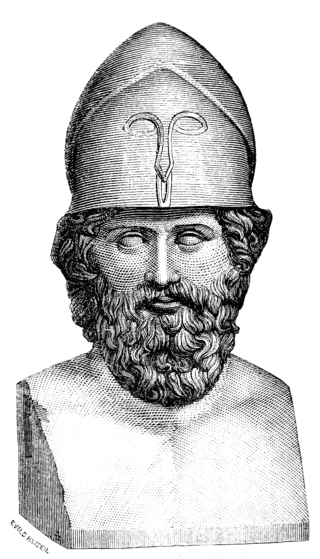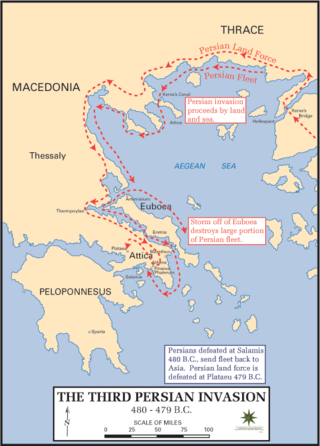Related Research Articles

Themistocles was an Athenian politician and general. He was one of a new breed of non-aristocratic politicians who rose to prominence in the early years of the Athenian democracy. As a politician, Themistocles was a populist, having the support of lower-class Athenians, and generally being at odds with the Athenian nobility. Elected archon in 493 BC, he convinced the polis to increase the naval power of Athens, a recurring theme in his political career. During the first Persian invasion of Greece, he fought at the Battle of Marathon, and may have been one of the ten Athenian strategoi (generals) in that battle.

The 5th century BC started the first day of 500 BC and ended the last day of 401 BC.
This article concerns the period 489 BC – 480 BC.

The Battle of Salamis was a naval battle fought in 480 BC, between an alliance of Greek city-states under Themistocles, and the Achaemenid Empire under King Xerxes. It resulted in a victory for the outnumbered Greeks. The battle was fought in the straits between the mainland and Salamis, an island in the Saronic Gulf near Athens, and marked the high point of the second Persian invasion of Greece. It was arguably the largest naval battle of the ancient world, and marked a turning point in the invasion.

Year 480 BC was a year of the pre-Julian Roman calendar. At the time, it was known as the Year of the Consulship of Vibulanus and Cincinnatus. The denomination 480 BC for this year has been used since the early medieval period, when the Anno Domini calendar era became the prevalent method in Europe for naming years.

The Battle of Thermopylae was fought in 480 BC between the Achaemenid Persian Empire under Xerxes I and an alliance of Greek city-states led by Sparta under Leonidas I. Lasting over the course of three days, it was one of the most prominent battles of both the second Persian invasion of Greece and the wider Greco-Persian Wars.

The Battle of Mycale was one of the two major battles that ended the second Persian invasion of Greece during the Greco-Persian Wars. It took place on or about August 27, 479 BC on the slopes of Mount Mycale, on the coast of Ionia, opposite the island of Samos. The battle was fought between an alliance of the Greek city-states, including Sparta, Athens and Corinth, and the Persian Empire of Xerxes I.

The Greco-Persian Wars were a series of conflicts between the Achaemenid Empire and Greek city-states that started in 499 BC and lasted until 449 BC. The collision between the fractious political world of the Greeks and the enormous empire of the Persians began when Cyrus the Great conquered the Greek-inhabited region of Ionia in 547 BC. Struggling to control the independent-minded cities of Ionia, the Persians appointed tyrants to rule each of them. This would prove to be the source of much trouble for the Greeks and Persians alike.

The Battle of Artemisium or Artemision was a series of naval engagements over three days during the second Persian invasion of Greece. The battle took place simultaneously with the land battle at Thermopylae, in August or September 480 BC, off the coast of Euboea and was fought between an alliance of Greek city-states, including Sparta, Athens, Corinth and others, and the Persian Empire of Xerxes I.

Artemisia I of Caria was a queen of the ancient Greek city-state of Halicarnassus, which is now in Bodrum, present-day Turkey. She was also queen of the nearby islands of Kos, Nisyros and Kalymnos, within the Achaemenid satrapy of Caria, in about 480 BC. She was of Carian-Greek ethnicity by her father Lygdamis I, and half-Cretan by her mother. She fought as an ally of Xerxes I, King of Persia against the independent Greek city states during the second Persian invasion of Greece. She personally commanded ships at the naval battle of Artemisium and at the naval Battle of Salamis in 480 BC. She is mostly known through the writings of Herodotus, himself a native of Halicarnassus, who praises her courage and relates the respect in which she was held by Xerxes.
Eurybiades was the Spartan navarch in charge of the Greek navy during the Second Persian invasion of Greece.

The Decree of Themistocles or Troezen Inscription is an ancient Greek inscription, found at Troezen, discussing Greek strategy in the Greco-Persian Wars, purported to have been issued by the Athenian assembly under the guidance of Themistocles. Since the publication of its contents in 1960, the authenticity of the decree has been the subject of much academic debate. The decree contradicted modern scholarly interpretations of Herodotus's account of the evacuation of Attica in 480 BC, in which it is stated that the evacuation was an emergency measure taken only after the Peloponnesian army failed to advance into Boeotia to fight the Persians. If the decree is authentic, the abandonment of Attica was part of a considered strategy aiming to draw the Persians into naval combat at Artemisium or Salamis.

The siege of Eretria took place in 490 BC, during the first Persian invasion of Greece. The city of Eretria, on Euboea, was besieged by a strong Persian force under the command of Datis and Artaphernes.
Amphictyonis in Greek mythology is a goddess of wine and friendship between nations, a local form of Demeter. Demeter was worshiped under this name at Anthela, because it was a meeting place for the amphictyons of Thermopylae, who offered sacrifices to her at the start of every meeting.

Xanthippus was a wealthy Athenian politician and general during the early part of the 5th century BC. His name means "Yellow Horse". He was the son of Ariphron and father of Pericles. A marriage to Agariste, niece of Cleisthenes, linked Xanthippus with the Alcmaeonid clan, whose interests he often represented in government. He distinguished himself in the Athenian political arena, championing the aristocratic party. His rivalry with Themistocles led to his ostracism, but he was recalled from exile when the Persians invaded Greece. Xanthippus' actions in the ensuing Greco-Persian Wars contributed significantly to the victory of the Greeks and the subsequent ascendancy of the Athenian Empire.

The Battle of the Eurymedon was a double battle, taking place both on water and land, between the Delian League of Athens and her Allies, and the Persian Empire of Xerxes I. It took place in either 469 or 466 BCE, in the vicinity of the mouth of the Eurymedon River in Pamphylia, Asia Minor. It forms part of the Wars of the Delian League, itself part of the larger Greco-Persian Wars.

The second Persian invasion of Greece occurred during the Greco-Persian Wars, as King Xerxes I of Persia sought to conquer all of Greece. The invasion was a direct, if delayed, response to the defeat of the first Persian invasion of Greece at the Battle of Marathon, which ended Darius I's attempts to subjugate Greece. After Darius's death, his son Xerxes spent several years planning for the second invasion, mustering an enormous army and navy. The Athenians and Spartans led the Greek resistance. About a tenth of the Greek city-states joined the 'Allied' effort; most remained neutral or submitted to Xerxes.

Korkyra was an ancient Greek city on the island of Corfu in the Ionian Sea that is adjacent to Epirus. It was a colony of Corinth that was founded in the Archaic period. Korkyra was acting as a port of call on the sailing routes, especially to reach the Italian coast or to venture farther north. According to Thucydides, the earliest recorded naval battle took place between Korkyra and Corinth, roughly 260 years before he was writing, and thus in the mid-7th century BC. He also writes that Korkyra was one of the three great naval powers in 5th-century BC Greece, along with Athens and Corinth.
Damasithymus was the king of Calyndos, a city in ancient Caria. His father was Candaules.
Styra was a town of ancient Euboea, on the west coast, north of Carystus, and nearly opposite the promontory of Cynosura in Attica. The town stood near the shore in the inner part of the bay, in the middle of which is the island Aegileia, now called Stouronisi. Styra is mentioned by Homer along with Carystus in the Catalogue of Ships in the Iliad. Its inhabitants were originally Dryopians, though they denied this origin, and claimed to be descended from the deme of Steiria in Attica. In the First Persian War (490 BCE) the Persians landed at Aegileia, which belonged to Styra, the prisoners whom they had taken at Eretria. In the Second Persian War (480-479 BCE) the Styrians fought at the battles of Artemisium, Salamis, and Plataeae. They sent two ships to the naval engagements, and at Plataeae they and the Eretrians amounted together to 600 men. They afterwards became the subjects of Athens, and paid a yearly tribute of 1200 drachmae. The Athenian fleet was stationed here in 356 BCE. Strabo relates that the town was destroyed in the "Maliac War" by the Athenian Phaedrus, and its territory given to the Eretrians; but as the Maliac War is not mentioned elsewhere, we ought probably to substitute Lamian War for it.
References
- ↑ United States Naval Institute Proceedings, Volume 68, 1942, p.662
- 1 2 Mark, Joshua (August 20, 2014). "Ten Noble and Notorious Women of Ancient Greece". World History Encyclopedia . Retrieved December 14, 2016.
- ↑ Meijer, Fik (2014). A History of Seafaring in the Classical World (Routledge Revivals). Routledge. ISBN 9781317701118.
- ↑ A New Classical Dictionary of Greek and Roman Biography Mythology and Geography, By Sir William Smith, Charles Anthony LLD, 1878 p.792
- ↑ Lightman, Marjorie (2008). A to Z of Ancient Greek and Roman Women. Infobase Publishing. p. 158. ISBN 0816067104.